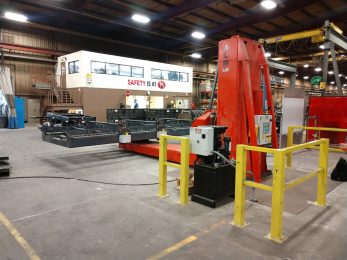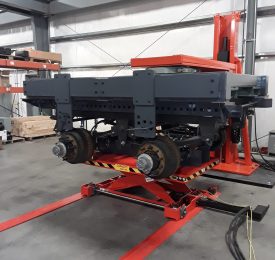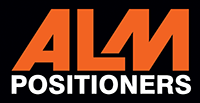Assembly line upgrade features positioners for safer, more efficient operations

Great Dane worked with ALM Positioners on a new way to rotate the trailer suspension during the build process, with a goal of improving the overall safety of the operation and increasing efficiency. Photo: ALM Positioners
By Kevin Jones
While looking to improve safety and efficiency throughout its manufacturing operations, Great Dane considered different ways of rotating the trailer suspension during the build process. More specifically, the company wanted to replace the chain hoist system used to attach bogie axles to the trailer frame.
The challenge was to come up with a system to lift and rotate the bogie that also would:
- Reduce the manual aspect (connecting the chains to the part, for instance)
- Be adaptable for the wide range of Great Dane trailer products
- Fit within the current assembly line footprint
- Be adaptable for implementation in multiple facilities
In late 2016, Great Dane contacted ALM Positioners and initiated a partnership.
“They were familiar with our product for standard welding applications,” recalls Colten Brunenn, the ALM technical sales engineer who worked on the project. “After multiple conversations and discussions, we reviewed nine concepts as we worked through all of the different capacities, all the different models of trailers, the layouts at all of the facilities and finally came to a conclusion. With a project of this scale, we knew that it was going to take some time.”
Great Dane chose ALM’s three-axis skyhook for assembly applications. The system features additional safety functions, with sensors and switches to ensure proper positioning before operations can proceed. The positioners were delivered in late 2018.
Brunenn points out that customers do occasionally want to duplicate a solution at another facility, but implementing those solutions at six different plants in the same time frame was “pretty unique.”
“The variability in the facilities was a challenge – every facility does things slightly different,” Brunenn said. “Overall, it went very smoothly.”
Alan Whiten, Great Dane Director of Manufacturing Engineering, concurs.
“We did encounter some height issues in two of our refrigerated trailer plants,” Whiten said. “The equipment design is very flexible and accommodated most of our layout needs without any modifications.”
And that’s what makes positioners an attractive solution, adds Kevin Toft, President of ALM Positioners.
“The positioner is as adaptive as the fixture allows it to be,” Toft says. “If we have a customer who is a trailer manufacturer with trailer bodies that go from 33 feet out to 52 feet on the same line, and we know that upfront, we can offer a solution with an adjustable tailstock. Or we have customers that have an application where they’ve put a drop-center between the headstock and tailstock that are fixed on the line or in the cell. The actual fixture adjusts for the different lengths of the part. In other applications, you’ve got independent tooling, and they’ll just move the tailstock for the different lengths.”
How positioners work
Generally, positioners can be categorized as single-column, headstock/tailstock, three axis or drop center, Toft explains. A positioner holds, lifts and rotates a part or tooling “like a chicken rotisserie” for assembly, welding or inspection. Positioners are typically used to replace material handling methods that utilize some combination of cranes, hoists and forklifts along with chains and straps to lift and rotate assemblies
“Hooking large parts to chains and cranes poses serious hazards to operators if they fall or swing uncontrolled,” Toft said.
The application of the positioner is to securely hold the part or weldment and properly position for welding, assembly or inspection. Additional ergonomic and safety improvements come from the removal of ladders, scaffolding and lifts to support welders and operators.
“We’ve come up with creative solutions to adapt our equipment into the required manufacturing scenario,” Toft said, adding that while ALM Positioners is a positioner manufacturer, it now is known for its comprehensive customer solutions in which positioners are a critical piece.
“We utilize a lot of our equipment to do neat things, working a lot with design-and-build companies and integrators.”
Additionally, ALM Positioner’s utilization of hydraulics has been a differentiator in the market, offering smaller footprints and faster speed. In 2019, the company received a patent for a hydraulic positioner precision control system to support automated and robotic applications.

The small footprint is a key feature of the ALM hydraulic positioning solution.
Safe is efficient
ALM works both with customers who, like Great Dane, want to improve the efficiency or safety of existing processes, as well as with customers who are “starting from scratch” and in the early phases of facility planning and design, Brunenn adds.
“In the long run, 90% of the time when we improve safety, you’re going to get additional benefits,” he said. “You’re going to increase your throughput, improve ergonomics and reduce your overhead crane time.”
Great Dane’s Whiten again credits the flexibility of the ALM Positioners system and its compatibility with the variety of suspensions being installed on the trailers.
“The ALM positioner improved the overall safety of the operation and increased plant efficiency,” Whiten said.
Toft likewise emphasizes the ALM Positioners mantra, “faster, safer, better.”
“We started with Great Dane with the idea of making it safer, then moved to the idea of making it faster and better as well, with improved ergonomics for operators and an added level of automation,” Toft said.
Direct Link to the Published Article

